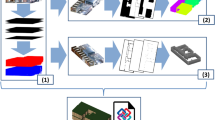Abstract
Automatic generation of building floor plans is useful in many emerging applications, including indoor navigation, augmented and virtual reality, as well as building energy simulation software. These applications require watertight models with limited complexity. In this paper, we present an approach that produces 2.5D extruded watertight models of building interiors from either 2D particle filter grid maps or full 3D point-clouds captured by mobile mapping systems. Our approach is to triangulate a 2D sampling of wall positions and separate these triangles into interior and exterior sets. We partition the interior volume of the building model by rooms, then simplify the model to reduce noise. Such labels are useful for building energy simulations involving thermal models, as well as for ensuring geometric accuracy of the resulting 3D model. We experimentally verify the performance of our proposed approach on a wide variety of buildings. Our approach is efficient enough to be used in real-time in conjunction with Simultaneous Localization and Mapping (SLAM) applications.
E. Turner—This research was conducted with Government support under and awarded by DoD, Air Force Office of Scientific Research, National Defense Science and Engineering Graduate (NDSEG) Fellowing, 32 CFR 168a.
Similar content being viewed by others
References
Adan, A., Huber, D.: 3D reconstruction of interior wall surfaces under occlusion and clutter. In: International Conference on 3D Imaging, Modeling, Processing, Visualization and Transmission, pp. 275–281 (2011)
Brunskill, E., Kollar, T., Roy, N.: Topological mapping using spectral clustering and classification. In: International Conference on Intelligent Robots and Systems, pp. 2491–3496, October 2007
Chauve, A.L., Labatut, P., Pons, J.P.: Robost piecewise-planar 3D reconstruction and completion from large-scale unstructured point data. In: CVPR (2010)
Chen, G., Kua, J., Shum, S., Naikal, N., Carlberg, M., Zakhor, A.: Indoor localization algorithms for a human-operated backpack system. In: 3D Data Processing, Visualization, and Transmission (2010)
Cheng, P., Anderson, M., He, S., Zakhor, A.: Texture mapping 3D planar models of indoor environments with noisy camera poses. In: SPIE Electronic Imaging Conference (2013)
Crawley, B.B., Kawrie, L.K., Pedersen, C.O., Winkelmann, F.C.: Energyplus: energy simulation program. ASHRAE 42(4), 49–56 (2000)
Fallon, M.F., Johannsson, H., Brookshire, J., Teller, S., Leonard, J.J.: Sensor fusion for flexible human-portable building-scale mapping. In: Intelligence Robots and Systems, pp. 4405–4412 (2012)
Funkhouser, T.A., Sequin, C.H., Teller, S.J.: Management of large amounts of data in interactive building walkthroughs. In: Proceedings of the 1992 Symposium on Interactive 3D Graphics, pp. 11–21 (1992)
Garland, M., Heckbert, P.S.: Surface simplification using quadric error metrics. In: SIGGRAPH pp. 209–216 (1997)
Grisetti, G., Stachniss, C., Burgard, W.: Improving grid-based slam with rao-blackwellized particle filters by adaptive proposals and selective resampling. In: Proceedings of IEEE International Conference of Robotics and Automation, pp. 2443–2448 (2005)
Grisetti, G., Stachniss, C., Burgard, W.: Improved techniques for grid mapping with rao-blackwellized particle filters. IEEE Trans. Robot. 23(1), 34–46 (2007)
Hahnel, D., Gurgard, W., Fox, D., Thrun, S.: An efficient fastslam algorithm for generating maps of large-scale cyclic environments from raw laser range measurements. In: International Conference on Intelligent Robots and Systems, vol. 1, pp. 206–211 (2003)
Holenstein, C., Zlot, R., Bosse, M.: Watertight surface reconstruction of caves from 3D laser data. In: IEEE/RSJ International Conference on Intelligent Robots and Systems (2011)
Kua, J., Corso, N., Zakhor, A.: Automatic loop closure detection using multiple cameras for 3D indoor localization. In: IS&T/SPIE Electronic Imaging (2012)
Lewis, R., Sequin, C.: Generation of 3D building models from 2D architectural plans. Comput. Aided Des. 30(10), 765–779 (1998)
Okorn, B., Xiong, X., Akinci, B., Huber, D.: Toward automated modeling of floor plans. In: 3DPVT (2009)
Or, S.H., Wong, K.H., kin Yu, Y., yuan Chang, M.M.: Highly automatic approach to architectural floorplan image understanding and model generation. Pattern Recogn. (2005)
Shen, S., Michael, N., Kumar, V.: Autonomous multi-floor indoor navigation with a computationally constrained mav. In: IEEE International Conference on Robotics and Automation, pp. 20–25 (2011)
Smith, M., Posner, I., Newman, P.: Adaptive compression for 3D laser data. Int. J. Robot. Res. 30(7), 914–935 (2011)
Thrun, S., Burgard, W., Fox, D.: Probabilistic Robotics. MIT Press, Cambridge (2005)
Turner, E., Zakhor, A.: Watertight as-built architectural floor plans generated from laser range data. In: 3DimPVT, October 2012
Turner, E., Zakhor, A.: Watertight planar surface meshing of indoor point-clouds with voxel carving. In: 3DV 2013 (2013)
U.S. Architectural and Transportation Barriers Compliance Board, 1331 F Street N.W. Suite 1000 Washington D.C. 20004-1111: Americans with Disabilities Act, July 1990. aNSI A117.1-1980
Xiao, J., Furukawa, Y.: Reconstructing the world’s museums. In: Fitzgibbon, A., Lazebnik, S., Perona, P., Sato, Y., Schmid, C. (eds.) ECCV 2012, Part I. LNCS, vol. 7572, pp. 668–681. Springer, Heidelberg (2012)
Author information
Authors and Affiliations
Corresponding author
Editor information
Editors and Affiliations
Rights and permissions
Copyright information
© 2015 Springer International Publishing Switzerland
About this paper
Cite this paper
Turner, E., Zakhor, A. (2015). Multistory Floor Plan Generation and Room Labeling of Building Interiors from Laser Range Data. In: Battiato, S., Coquillart, S., Pettré, J., Laramee, R., Kerren, A., Braz, J. (eds) Computer Vision, Imaging and Computer Graphics - Theory and Applications. VISIGRAPP 2014. Communications in Computer and Information Science, vol 550. Springer, Cham. https://doi.org/10.1007/978-3-319-25117-2_3
Download citation
DOI: https://doi.org/10.1007/978-3-319-25117-2_3
Published:
Publisher Name: Springer, Cham
Print ISBN: 978-3-319-25116-5
Online ISBN: 978-3-319-25117-2
eBook Packages: Computer ScienceComputer Science (R0)




